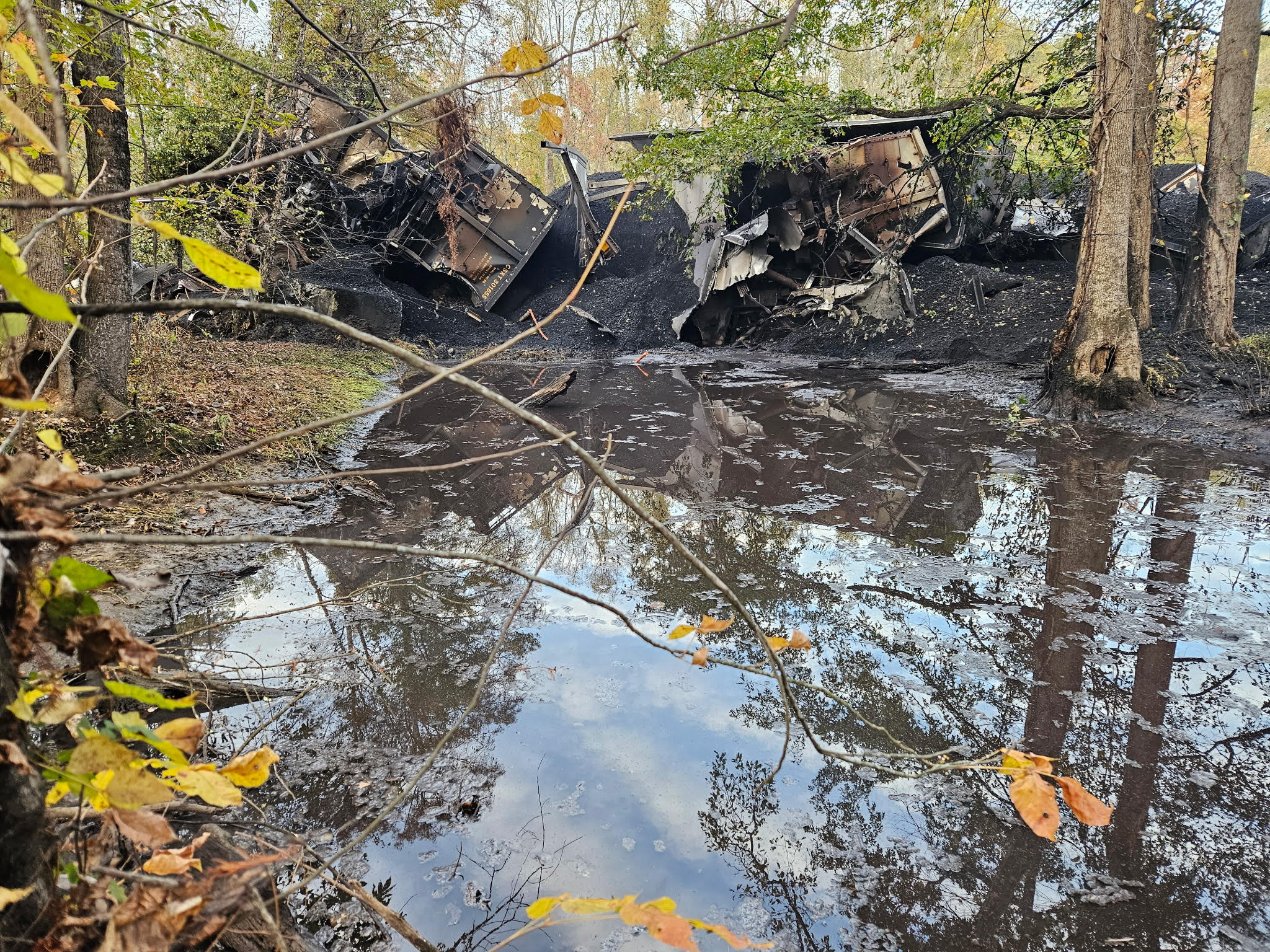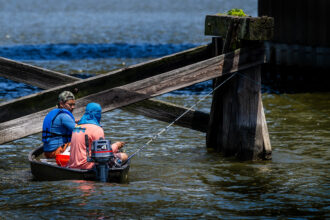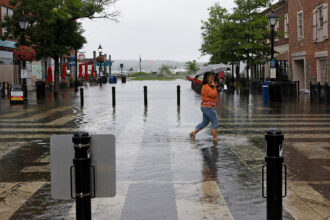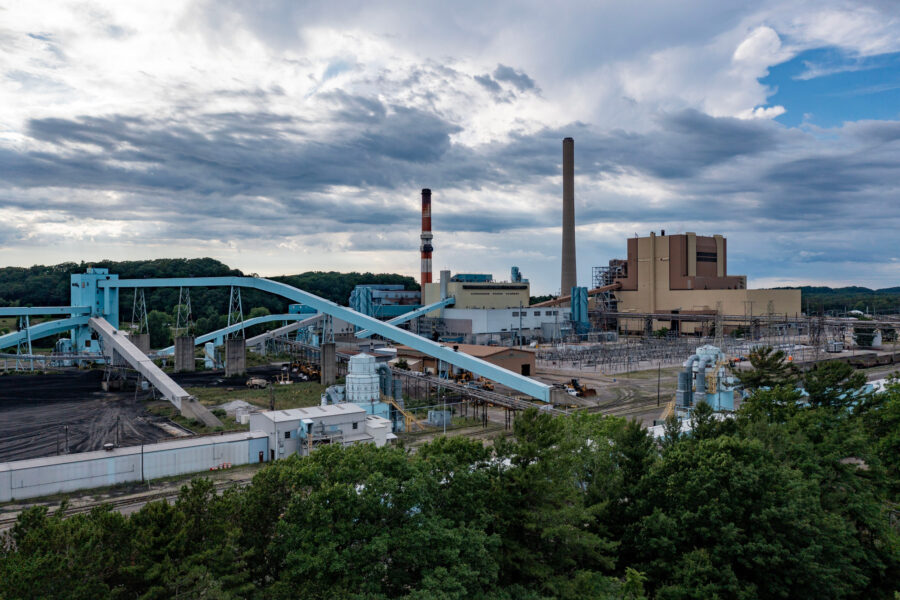A train derailment last Saturday dumped coal and diesel fuel into wetlands near the Chickahimony River in Virginia, and nearby residents and environmentalists worry that the contaminants could flow into the waterway.
The CSX train travelling from Hinton, West Virginia, to Newport, Virginia, derailed about 30 minutes past Richmond in New Kent County, sending 53 cars full of coal and two engines with diesel fuel to within about 400 feet of the river, one of several tributaries feeding into the James River that flows into the Chesapeake Bay.
“There were no injuries as a result of the incident and no hazardous materials being transported by the cars involved and no danger to the surrounding community,” the company said in a statement on Monday.
But the 4,000 gallons of diesel fuel and about 4,000 tons of coal that spilled into wetlands between the tracks and the river have proven difficult for environmental personnel to access to cleanup. Fencing, booms and “turbidity curtains” were deployed to keep the diesel fuel and coal from reaching the river.
According to John Giese, a Virginia Department of Environmental Quality spokesperson, “containment and cleanup of spilled diesel fuel began shortly after the derailment.” That includes using two booms to prevent any diesel from entering the river and using sorbent materials to collect diesel that is on any water surfaces, Giese said.
“There is some residual fuel in the wetlands. We know that and that has to be addressed,” Giese said.
“The coal is primarily a physical contaminant,” Giese said, meaning that “as the rail cars of coal derailed, the spilled coal would have smothered flora and fauna on which it came to rest.” The diesel fuel, however, “can impact plants and animals due its toxicity.”
On Wednesday, CSX said it was continuing “to work in close coordination with the U.S. Environmental Protection Agency and the Virginia Department of Environmental Quality on our response efforts.”
CSX released information on the derailment last Saturday, but didn’t disclose the amounts of diesel fuel and coal that had spilled until Thursday. That day, the rail company said its “primary focus” is the health and safety of workers and the surrounding community, and “mitigating potential risk to the environment.”
The cause of the derailment is under investigation, but it has the surrounding community concerned, including the Chikahominy Tribe that derives its name from the river. Dana Adkins, the environmental director with the tribe, said they are watching the impact to the wetlands, which could harm the river that his people lived on centuries ago.
“It potentially could be decades that we’re still seeing impacts from this,” said Adkins.
.
The environmental community in the surrounding area is also concerned. On Tuesday, the James River Association, an environmental nonprofit advocating to protect the state’s largest watershed, said: “We are deeply concerned about the impacts to the Chickahominy River, surrounding wetlands, and the people who work and live around the derailment site.”
“The Chickahominy is a unique and critical tributary of the James River and the greater Chesapeake Bay, providing critical environmental benefits and habitat to plants and wildlife,” said Tom Dunlap, James Riverkeeper at the James River Association. “Many of the neighboring property owners have spent years or decades working on conservation practices to protect this area for the important resource that it is, and seeing this happen is a punch in the gut.”
The incident evokes memories of the Norfolk Southern train derailment in East Palestine Ohio in February 2023 that released hazardous materials and created concerns about the safety of drinking water in the area.
“The closest surface water intake on the Chickahominy River is located approximately 13 miles downriver from the incident site,” Giese, the Virginia DEQ spokesperson, said in a statement. “This intake is operated by Newport News Waterworks. Containment measures have been installed at the incident site to limit migration of residual diesel fuel and coal. There is no current risk to the drinking water intake.”
Giese said “timber mats” are being used to create a temporary access road to clean up the material. As of Thursday morning, Giese said containment and cleanup of the diesel fuel “continues” and the coal was “being staged for removal.”
The spills of diesel fuel and coal have the Chickahominy Tribe concerned because of its recent acquisition of a 900-acre property that previously belonged to them before they were pushed off it by the country’s early colonists. The land, downstream of the derailment, has great cultural and historical value to the tribe and wild rice is also grown on the property. Because PFOS was detected in the river, and in fish tissue, prior to the derailment, Adkins said his next question is, “What’s the impact on plants?”
Dunlap of the James River Association said the site of the crash is in the top 3.5 percent of Virginia lands for ecological core value, according to information the association has received from the Virginia Department of Conservation and Recreation.
Parts of the river downstream have protected lands home to freshwater mussels, underwater grasses and a nursery habitat for migratory fish. The James River Association recently released its biannual State of the James River health report card, grading the James River a B.
“The coal train spill in the Chickahominy is yet another reminder that accidents like this can threaten river health and some of our most indispensable natural resources in the Commonwealth, and that continued investment in and maintenance of our infrastructure are essential prevention tools,” Dunlap said. “In the coming days and weeks, we will continue to closely monitor the situation and work with partners to assess the damage and ensure appropriate followup actions are taken.”
Mike Gerel, the Virginia science manager for the Chesapeake Bay Foundation, another environmental group focused on the 64,000 mile watershed, echoed concern about how the restoration of the wetlands would be ensured.
This story is funded by readers like you.
Our nonprofit newsroom provides award-winning climate coverage free of charge and advertising. We rely on donations from readers like you to keep going. Please donate now to support our work.
Donate Now“This is one of those times that emphasizes the benefits of installed renewable energy like wind and solar, as we don’t need to transport source materials with risk for a spill,” Gerel said. “The power source comes to the site free from nature.”
Compounding the cleanup is the federal government shutdown, which the James River Association says may end support from the EPA.
“DEQ has been coordinating with both the U.S. Army Corp of Engineers and EPA since the beginning of the incident,” Giese said. “An EPA federal on-scene coordinator responded to the incident shortly after it occurred. EPA continues to maintain a federal on-scene coordinator presence along with DEQ” as the state on-scene coordinator.
It’s not immediately clear how common train derailments are in Virginia, but in April 2014, a CSX train carrying crude oil derailed in Lynchburg, about two hours west of Richmond on the eastern edge of the Appalachian coalfields region. Oil in the James River caught fire after the spill.
Coal is routinely transported by rail to Eastern Virginia. The Hampton Roads area, which includes Norfolk, is home to the country’s largest coal port complexes, and the state is the leading exporter of U.S. coal, according to the U.S. Energy Information Administration.
Virginia has 41 operating coal mines that comprise about 2 percent of the country’s coal production, but almost all the coal leaving Virginia’s ports comes from other states.
About This Story
Perhaps you noticed: This story, like all the news we publish, is free to read. That’s because Inside Climate News is a 501c3 nonprofit organization. We do not charge a subscription fee, lock our news behind a paywall, or clutter our website with ads. We make our news on climate and the environment freely available to you and anyone who wants it.
That’s not all. We also share our news for free with scores of other media organizations around the country. Many of them can’t afford to do environmental journalism of their own. We’ve built bureaus from coast to coast to report local stories, collaborate with local newsrooms and co-publish articles so that this vital work is shared as widely as possible.
Two of us launched ICN in 2007. Six years later we earned a Pulitzer Prize for National Reporting, and now we run the oldest and largest dedicated climate newsroom in the nation. We tell the story in all its complexity. We hold polluters accountable. We expose environmental injustice. We debunk misinformation. We scrutinize solutions and inspire action.
Donations from readers like you fund every aspect of what we do. If you don’t already, will you support our ongoing work, our reporting on the biggest crisis facing our planet, and help us reach even more readers in more places?
Please take a moment to make a tax-deductible donation. Every one of them makes a difference.
Thank you,













